Fragrant native shrubs offer living boundaries that delight senses while supporting wildlife. You’ll find excellent options in Sweetshrub, Viburnum varieties, and Inkberry Holly—all providing privacy with aromatic benefits. Plant these in staggered bloom cycles, combining spring-flowering lilacs with summer-blooming mock orange and fall-persistent abelia for year-round scent. Proper spacing and seasonal pruning keep your aromatic border thriving. Discover how these natural boundaries can transform your landscape into a multi-layered sanctuary.
Essential Fragrant Native Shrubs for Defining Boundaries

While traditional fencing materials offer quick solutions, fragrant native shrubs provide a living boundary that engages multiple senses and supports local ecosystems.
You’ll find options like Sweetshrub and Southern Arrowwood deliver aromatic blooms while creating habitat for wildlife and pollinators.
For hedges for privacy, consider Burkwood Viburnum, which grows to 10 feet tall in partial sunlight and fills your garden with its sweet fragrance.
Inkberry Holly offers dense evergreen foliage reaching 6-12 feet, providing year-round screening while attracting birds with its berries.
Buttonbush, native to North America, grows 6-12 feet tall with glossy foliage and fragrant white flowers.
Incorporating these fragrant shrubs along with Fragrant Viburnum and Sweet Box not only defines your property but also enhances local biodiversity and ecological health.
Seasonal Bloom Cycles of Scented Hedge Plants
Understanding when your hedge plants will bloom helps you create a landscape with year-round sensory appeal. Many fragrant shrubs like lilacs and viburnums welcome spring with vibrant colors and intoxicating scents that announce the season’s arrival.
Timing your hedge blooms creates a symphony of scents and colors throughout the changing seasons.
As spring shifts to summer, mock orange takes center stage with its large, white blooms that smell remarkably like orange blossoms.
Sweetshrub follows with its unusual spider-like flowers offering surprising scents from citrus to banana throughout the summer.
For extended seasonal bloom cycles, consider reblooming lilac varieties like ‘Josee’ that flower multiple times during the growing season.
To guarantee your fragrant flowers continue into fall, incorporate abelia shrubs with their tubular blooms that persist from June until autumn’s first frost.
Creating Wildlife-Friendly Borders With Aromatic Natives
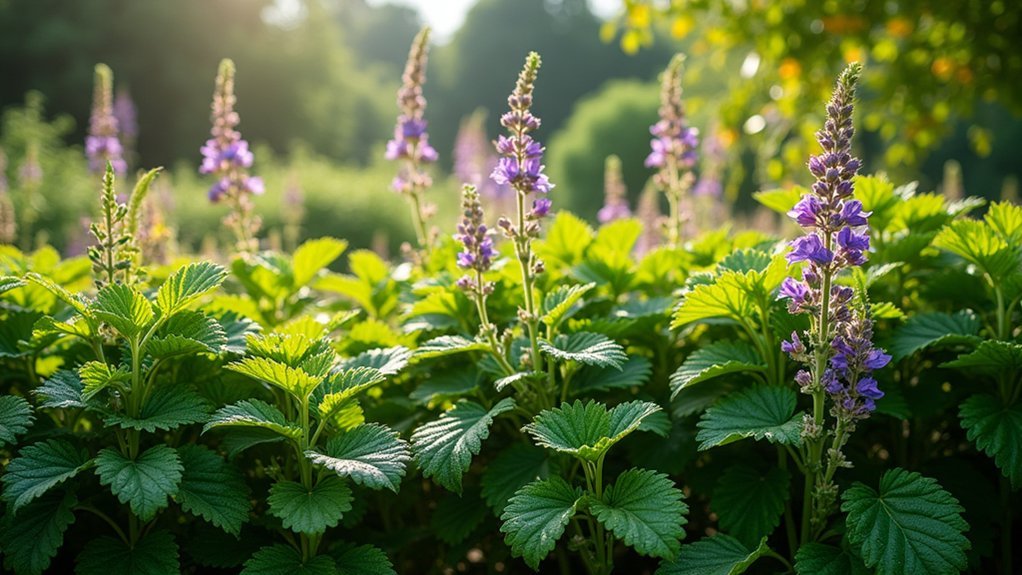
You’ll transform your garden boundaries into vibrant scented native corridors that attract a multitude of wildlife throughout the year.
These pollinators’ paradise pathways feature aromatic native shrubs like sweetshrub and viburnum that naturally thrive in your local climate while requiring minimal maintenance.
Scented Native Corridors
Creating a border with scented native plants transforms ordinary garden boundaries into vibrant ecological corridors that benefit both you and local wildlife. By selecting fragrant hedges like Sweetshrub and Fragrant Viburnum, you’ll establish natural boundaries that offer privacy while supporting biodiversity.
These flowering shrubs create sensory-rich experiences in your garden while requiring less maintenance than non-natives, as they’re already adapted to local conditions. For year-round interest, incorporate evergreen shrubs alongside deciduous varieties that bloom at different times, ensuring continuous fragrance and food sources for pollinators.
Your scented corridor will serve multiple purposes: defining spaces naturally, attracting beneficial insects, and creating habitat for birds and small mammals. The result is a sustainable, aromatic boundary that enhances your outdoor living experience while contributing positively to the local ecosystem.
Pollinators’ Paradise Pathways
Transforming your garden boundaries into pollinator havens starts with the intentional selection of aromatic native plants. Fragrant shrubs like sweetshrub, viburnum, and mock orange create inviting corridors that support local biodiversity while requiring minimal maintenance.
When designing your wildlife-friendly borders, consider:
- Seasonal succession – Combine flowering and evergreen fragrant shrubs for year-round habitat and food sources
- Water efficiency – Native plants naturally require less irrigation while providing essential resources for pollinators
- Corridor connectivity – Position aromatic hedges to create natural pathways that facilitate pollinator movement throughout your landscape
These scented native corridors do more than define your garden’s edges—they establish ecological networks that sustain bees, butterflies, and beneficial insects while adding sensory richness to your outdoor space.
Seasonal Aromatic Transitions
While garden borders often serve merely as property boundaries, thoughtfully selected aromatic native plants transform these spaces into dynamic seasonal showcases that support local wildlife year-round.
Varieties like lilac and mock orange offer scented blooms in spring, creating not just fragrance but essential habitats for birds and beneficial insects.
You’ll enjoy continuous sensory experiences as sweetshrub and viburnum take over in summer, extending your garden’s appeal through multiple seasons.
These fragrant shrubs attract pollinators including bees and butterflies, building biodiversity in your landscape.
The beauty of native aromatics lies in their adaptability—drought-tolerant species thrive in various soil types while requiring minimal maintenance.
Planting Techniques for Establishing Fragrant Property Lines
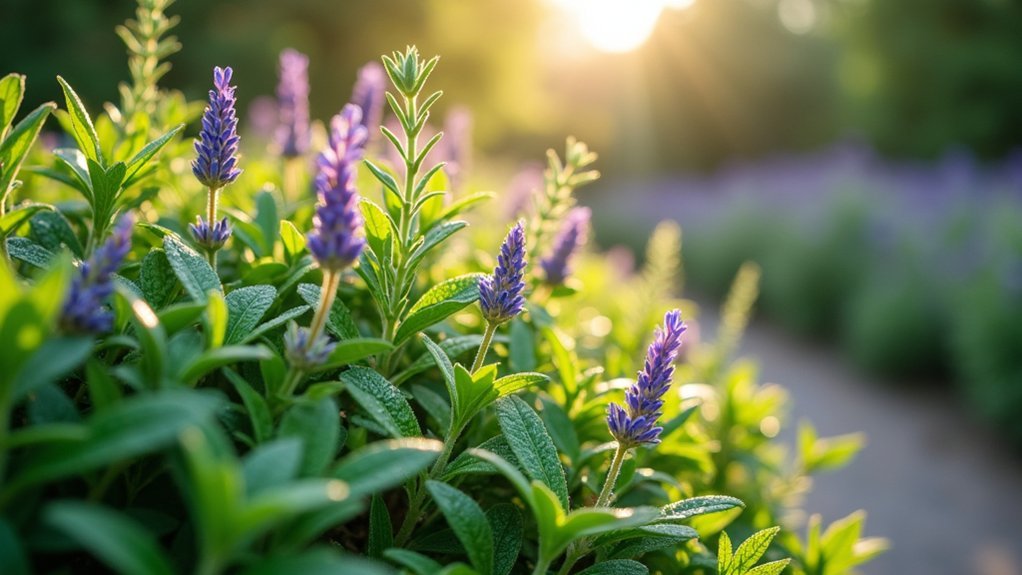
Successful establishment of fragrant property lines depends on thoughtful planning and proper planting techniques that consider your specific growing conditions.
When you plant a hedge with aromatic varieties, proper spacing becomes essential for developing robust fragrant blooms and ensuring adequate airflow between hedge plants.
For ideal results:
- Select a diverse mix of shrubs like Mock Orange and Sweetshrub that thrive in your hardiness zone to create continuous sensory appeal.
- Space plants appropriately to allow for mature growth while maintaining good air circulation.
- Implement a consistent watering schedule during the establishment phase, monitoring soil moisture regularly.
Annual pruning will maintain your hedge’s shape while encouraging vigorous new growth that maximizes aromatic impact.
Drought-Tolerant Scented Shrubs for Natural Fencing
When water conservation becomes a priority for your landscape, drought-tolerant scented shrubs offer an elegant solution for natural fencing that appeals to multiple senses.
Sweetshrub thrives in hardiness zones 5-9, adapting to various sunlight conditions while providing aromatic boundaries.
Mock Orange delivers fragrant white blooms and grows 2-10 feet tall, creating privacy with minimal water requirements once established.
For warmer regions (zone 8+), consider Pittosporum with its glossy foliage and delicate, fragrant flowers.
Abelia’s continuous blooming from spring through fall makes it an excellent low-maintenance option that thrives in multiple soil types.
You’ll also find Viburnum varieties particularly versatile for drought-prone areas in zones 2-8, offering fragrant blooms that enhance both the scent and visual appeal of your hedges.
Maintenance Strategies for Fragrant Hedge Longevity

Keeping your fragrant hedge in peak condition requires mastering two key maintenance areas.
You’ll need to develop a seasonal pruning schedule that maintains the hedge’s shape while encouraging dense growth and maximum flower production.
Proper nutrient management, including timely applications of balanced fertilizers, will support robust root systems and enhance the aromatic qualities that make your living fence so special.
Seasonal Pruning Techniques
Proper seasonal pruning stands as the cornerstone of maintaining vibrant, fragrant hedges that continue to delight year after year.
You’ll maximize your flowering shrubs’ potential by pruning just after they bloom, ensuring you don’t accidentally remove next season’s buds. This timing encourages robust new growth where fragrant flowers will eventually emerge.
For ideal results, follow these essential practices:
- Remove dead or diseased branches during dormant seasons to improve air circulation and reduce pest risks.
- Implement thinning techniques to enhance light penetration, critical for fragrant flowers to develop their fullest scent.
- Always use sharp, clean pruning tools for precise cuts that heal quickly and minimize plant stress.
These pruning techniques not only maintain your hedge’s attractive shape but also greatly enhance its flowering and fragrance capabilities.
Nutrient Balance Essentials
Beyond the pruning shears lies another fundamental aspect of hedge care—the nutrient balance that fuels your fragrant garden stars. Testing your soil regularly reveals whether amendments are needed to support peak health and fragrance production in your living boundary.
For maximum benefit, incorporate organic fertilizers like compost or well-rotted manure into your maintenance routine. These natural options improve soil structure while slowly releasing essential nutrients that fragrant hedges crave.
Coupled with a consistent watering schedule, especially during dry periods, you’ll guarantee your plants can effectively absorb available nutrients.
This balanced approach to plant nutrition complements your pruning efforts, creating an environment where fragrant hedges thrive year after year. The combination of proper feeding, watering, and pruning removes stress factors that might otherwise shorten your hedge’s productive lifespan.
Combining Natives for Year-Round Scent and Privacy
When you thoughtfully blend native plants into your hedge design, you’ll create a living boundary that delights the senses while supporting local ecosystems.
By selecting species with staggered blooming periods, you’ll enjoy fragrant blooms throughout the growing season while providing essential habitat for pollinators.
Mix deciduous flowering shrubs like Lilac and Forsythia with evergreen foliage such as Inkberry Holly for continuous coverage.
This strategic combination guarantees your hedge remains functional during winter months while delivering seasonal interest.
For maximum impact, consider these three approaches:
- Pair Sweetshrub with Fragrant Viburnum for complementary scent profiles
- Include Southern Arrowwood and Mock Orange for extended blooming periods
- Layer tall and medium-height natives to create depth and enhance privacy
This diverse planting strategy delivers year-round beauty while requiring minimal maintenance due to the plants’ natural adaptation to local conditions.
Regional Selections of North American Scented Barriers

The vast geographic diversity across North America calls for thoughtful selection of scented hedge plants suited to your specific region.
In cooler northern areas (zones 2-4), you’ll find Viburnum species offering resilient fragrant options that attract beneficial pollinators while forming effective barriers.
For the middle regions (zones 4-7), Mock Orange delivers spectacular white blooms with intense fragrance, while Lilacs provide colorful spring displays across zones 3-9.
If you’re gardening in warmer southern territories (zones 5-9), consider Sweetshrub (Calycanthus) for its unique scent and adaptability to various light conditions.
Those in the warmest climates (zone 8+) should explore evergreen choices like Pittosporum, providing year-round privacy, subtle fragrance, and low-maintenance benefits even in challenging conditions.
Pollinator Support Through Fragrant Boundary Plantings
Your fragrant hedge can serve as a pollinator paradise when you select butterfly-attracting options like lilac and viburnum alongside bee-friendly varieties such as mock orange and sweetshrub.
By choosing plants with overlapping bloom periods, you’ll create a continuous nectar flow that supports pollinators throughout spring and summer.
Native scented barriers prove especially valuable for sustaining local pollinator populations while adding aromatic appeal to your garden boundaries.
Butterfly-Attracting Hedge Options
Fragrant flowering hedges serve as natural magnets for butterflies while elegantly defining your garden’s boundaries. Native shrubs with abundant blooms create ideal nectar sources that support these delicate pollinators throughout their active seasons.
Plants like lilacs, viburnums, and mock orange deliver both visual appeal and essential habitat benefits.
For maximum butterfly attraction, consider these strategic options:
- Select native flowering shrubs that adapt easily to your local conditions, ensuring reliable blooms and sustained nectar production.
- Incorporate varieties with different blooming periods, such as sweetshrub and viburnum, to provide continuous butterfly support.
- Maintain your hedges with regular pruning to encourage denser growth and more abundant flowers.
Your fragrant hedge choices do more than beautify your landscape—they actively contribute to local ecosystem diversity while creating a living, breathing boundary.
Bee-Friendly Fragrant Varieties
Beyond attracting butterflies, strategic planting of scented hedge varieties can transform your garden boundaries into buzzing sanctuaries for bees and other crucial pollinators.
Incorporating bee-friendly fragrant varieties like Summersweet and Sweet Box provides essential nectar sources throughout the growing season.
Mock Orange and Sweetshrub aren’t just aromatic additions—they’re pollinator powerhouses that require minimal maintenance due to their native adaptations.
Consider Viburnums for their dual benefits: large fragrant bloom clusters that bees adore and nutritious berries that sustain birds.
For year-round pollinator support, select fragrant shrubs that bloom at different times, creating a continuous food supply.
Gardenias and Darling Daphne create sensory-rich environments that attract and sustain significant pollinator populations while serving as beautiful, functional boundaries for your outdoor space.
Seasonal Nectar Flow
While every garden provides some level of ecological value, strategically designed fragrant hedge plantings can create a continuous nectar flow that sustains pollinators throughout the growing season.
By selecting diverse fragrant flowering shrubs that bloom at different times, you’ll establish a reliable food source for bees and butterflies.
For maximum seasonal nectar flow, consider:
- Mix evergreen and deciduous fragrant plants to maintain year-round resources
- Include spring bloomers like lilac and mock orange for early-season pollinators
- Add late-season varieties such as sweetbox or viburnum for fall nectar sources
Native fragrant species like southern arrowwood adapt well to local conditions while supporting indigenous pollinators.
This thoughtful approach to hedge planting not only creates sensory-rich boundaries but also enhances biodiversity in your garden ecosystem.
Designing Multi-Layered Aromatic Living Fences
When you’re planning a garden boundary that delights multiple senses, a multi-layered aromatic living fence offers both beauty and functionality. By combining fragrant shrubs like lilacs and mock oranges with evergreen hedge plants such as Pittosporum, you’ll create year-round privacy with seasonal bursts of fragrance.
| Layer | Plant Options | Benefits | Maintenance |
|---|---|---|---|
| Back | Evergreen Pittosporum, Abelia | Year-round privacy | Yearly shaping |
| Middle | Viburnum, Lilac | Strong fragrance | Spring pruning |
| Front | Sweet shrub, Mock orange | Seasonal blooms | Deadheading |
| Ground | Aromatic herbs | Pest deterrence | Regular trimming |
Choose native aromatic plants when possible—they’ll support local wildlife while requiring less maintenance. Regular pruning enhances your hedge’s shape and promotes healthier growth, ensuring your living fence continues providing sensory delight through all seasons.
Frequently Asked Questions
What Is the Most Fragrant Hedge?
The most fragrant hedge varies, but you’ll find Sweet Viburnum, Mock Orange, and Gardenias top the list. They’ll fill your garden with delightful scents while creating natural boundaries and attracting beneficial pollinators.
What Is the Best Plant to Block Neighbors’ Views?
For blocking neighbors’ views, you’ll find Boxwood most effective as it grows up to 20 feet tall and provides year-round screening. Pittosporum and Mock Orange also offer excellent dense coverage while adding beautiful fragrance.
What Is the Most Fragrant Bush?
Gardenias are considered the most fragrant bush, with their intense sweet scent reminiscent of coconut and vanilla. You’ll also enjoy Daphne’s waxy pink flowers and Viburnum species that attract pollinators while providing wonderful fragrance.
What Is the Best Border Hedge?
The best border hedge depends on your needs. You’ll find excellent options in fragrant Mock Orange, vibrant Lilacs, evergreen Pittosporum and Holly, or versatile Abelia. Consider your climate zone before making your choice.
In Summary
By selecting native, fragrant hedges for your boundaries, you’re creating more than just privacy—you’re establishing living ecosystems that delight the senses year-round. You’ll enjoy the changing bloom cycles while supporting local wildlife and pollinators. Whether you’ve chosen drought-tolerant varieties or layered multiple species, your aromatic natural fence offers beauty, fragrance, and ecological benefits that traditional barriers simply can’t match.
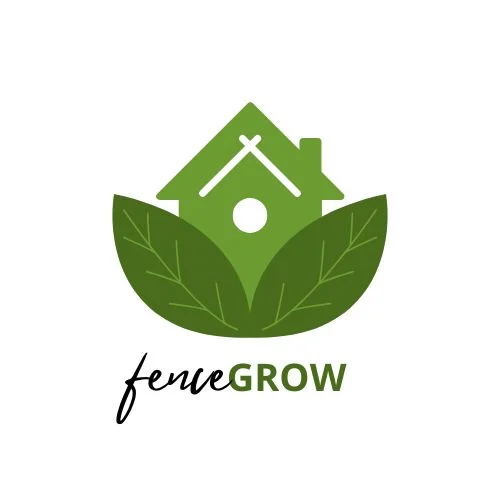
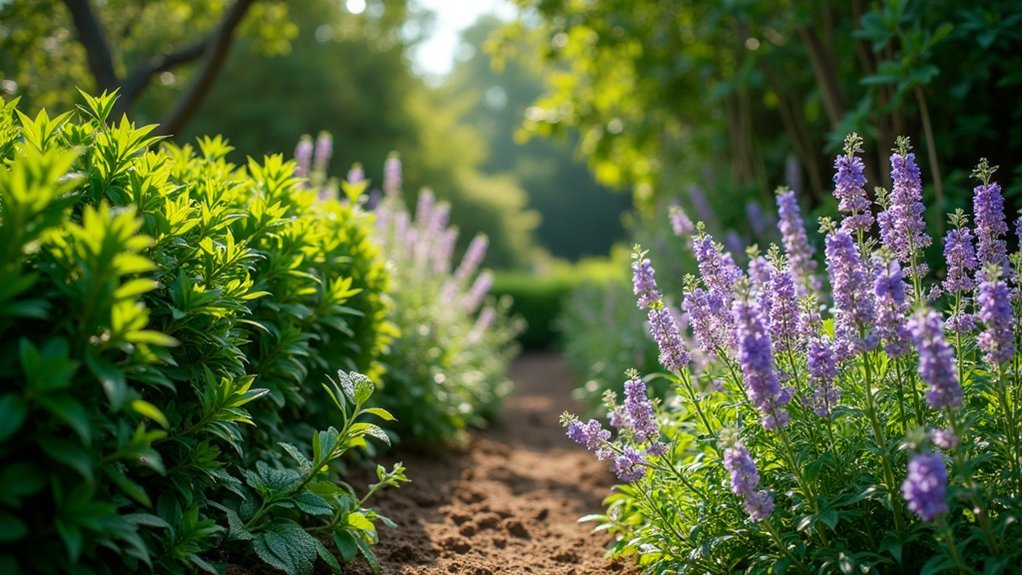

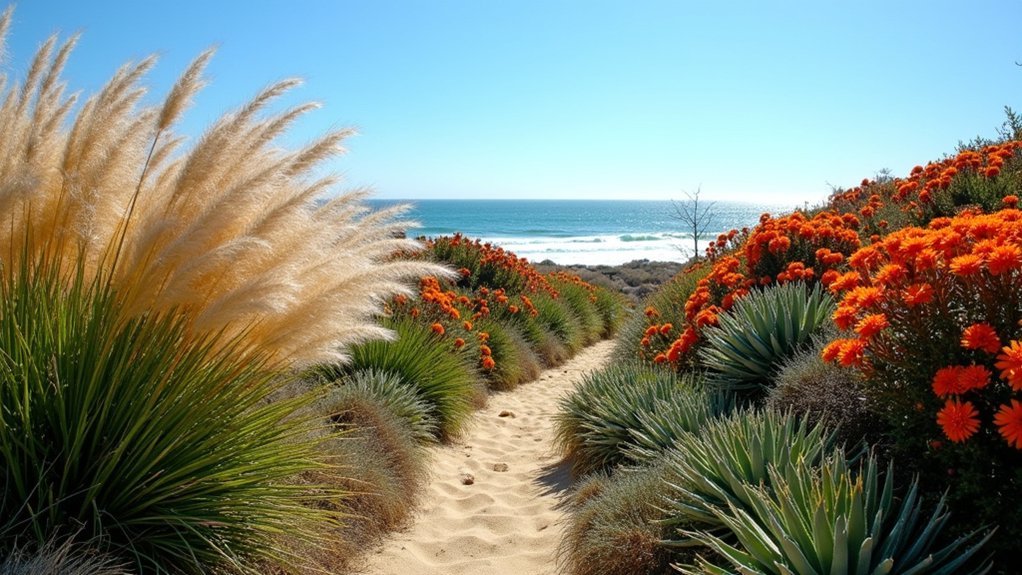
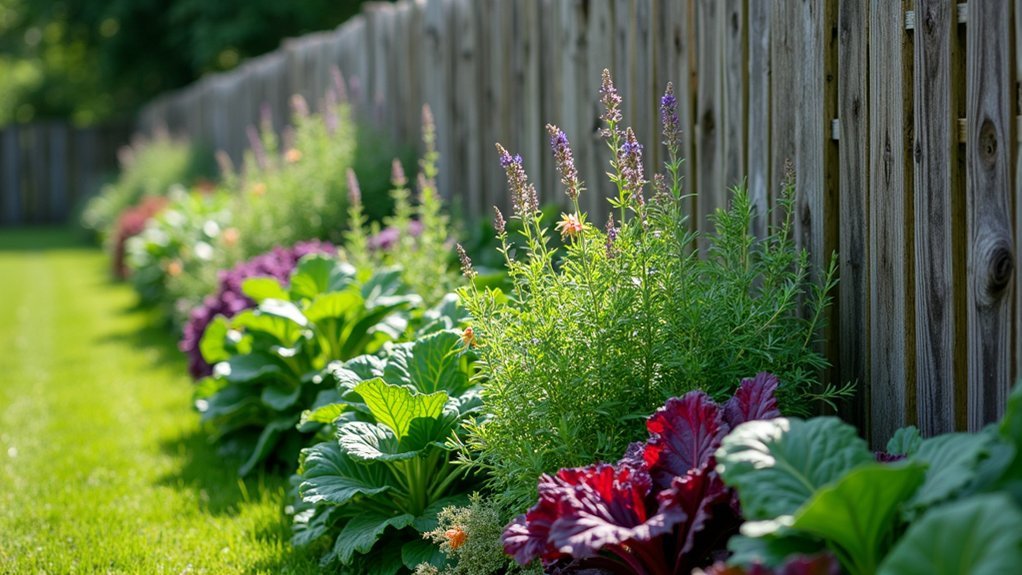
Leave a Reply